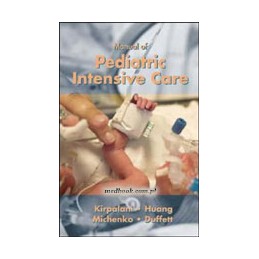- Obniżka


 Dostawa
Dostawa
Wybierz Paczkomat Inpost, Orlen Paczkę, DHL, DPD, Pocztę, email (dla ebooków). Kliknij po więcej
 Płatność
Płatność
Zapłać szybkim przelewem, kartą płatniczą lub za pobraniem. Kliknij po więcej szczegółów
 Zwroty
Zwroty
Jeżeli jesteś konsumentem możesz zwrócić towar w ciągu 14 dni*. Kliknij po więcej szczegółów
An introduction for beginners and a valuable aid for those already engaged in the care of acutely ill children, the Manual of Pediatric Intensive Care comprises contributions from specialists from around the world, including doctors, nurses, pharmacists and respiratory therapists.
Opis
1: Introduction to Pediatric Critical Care
2: Rapid Response Systems/Medical Emergency
3: Transport
4: Monitoring in the ICU
A. Noninvasive Monitoring
B. Lung Volumes
C. Invasive Monitoring
5: Resuscitation
A. Oxygen Delivery/ Airway Management
B. Shock
C. Cardiopulmonary Resuscitation
6: Pulmonary
A. CF
B. Bronchiolitis
C. Status Asthmaticus
D. Mechanical Ventilation of Pediatric Patients
E. Acute Repiratory Disease Syndromes
7: Otolaryngology
A. General Approach to ENT Problems
B. Nasal Obstruction
C. Oropharyngeal Obstruction
D. Laryngeal Obstruction
E. Tracheal Obstruction
F. Tracheotomy
G. Upper Airway Infections
8: Cardiac
A. Cardiac Assessment
B. Arrhythmia
C. Heart Failure
D. Cardiomyopathy
E. Congenital Heart Disease – Perioperative Care
F. Perioperative Care of a Child with CHD
G. ECMO
9: Neurology
A. Neurologic Assessment in the PICU
B. Status Epilepticus
C. Coma
D. Neuroprotection in the PICU
10: Neurosurgery
A. Care of the post operative neurosurgical patient
B. Ventricular drainage / ICP monitoring
11: Anesthesia / sedation
12: Fluids and Electrolytes
13: Renal Failure
A. Hypertensive Emergencies
B. Hemolytic Uremic Syndrome
C. Acute renal failure
D. Continuous Renal Replacement Therapy
E. Renal transplant
13: GI
A. GI bleed
B. Short Gut
C. Pancreatitis
D. Fulminant Hepatic Failu
E. Liver transplant
14: Nutrition
A. Assessment of caloric needs / nutrition
B. Enteral
C. Parenteral Nutrition
15: Endocrine
A. Adrenal Insufficienc y
B. Hypoglycemia
C. Thyroid Storm
D. Sick Euthyroid Syndrome
E. Diabetes Insipidus
F. SIADH
G. Calcium Disorders
H. DKA
16: Hematology / Oncology
A. Hematology (Anemia, Sickle Cell, Thrombocytopenia, Blood Products)
B. Clotting
C. HLH
D. Superior Vena Cava Syndrome / Spinal Cord Compression
E. Hypercalcemia of Malignancy
F. Hyper leukocytosis
G. Tumour lysis syndrome
H. Fever and Neutropenia
I. Graft Versus Host Disease
J. Veno-Occlusive Disease
17: Infection
A. Septic shock
B. Toxic shock
C. Meningitis / encephalitis
D. Pneumonia
E. Bacteremia
F. Necrotizing fascitis
G. Immunocompromised patients
H. Nosocomial infections
18: Metabolic Disease
19: Trauma – Section editor Anchala
A. Polytrauma / trauma resus
B. Head injury
C. C-Spine Management
D. Burns
E. Child Abuse
20: Psychosocial Support
A. Legal Considerations
B. Psychosocial Support in the PICU, DNAR
21: Radiology guide
22: End of Life Care
A. Determination of Death
B. Organ/Tissue Donation
23: Procecures
24: Pharmacology
A. Drug Levels/Dosing
B. Toxicology
C. Formulary
25: Reference Values
